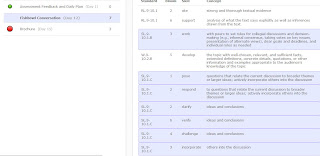I just got home from a PD about this amazing new
Common Core resource... It's a website called
Course Mason and it was designed by a local assistant superintendent. It has all the big essentials in one place - Standards, Essential Questions, Resources, everything! The best part is - it's free! If you read my previous post, this is basically an electronic version of the
Big Binder!
Here are some pictures of what I worked on today, so you can see what this program offers:
When you log in, it sets you up with your different courses/classes -- I'm lucky enough to just have 2 preps, but you can create as many as you need.
The entire thing is really easy to navigate -- huge buttons at the top and sides in order to find everything that you need.
The first thing you're asked to do is choose which standards you need to apply to your course... this site has all the Common Core standards and they're adding more every day. When I spoke to the developer, he said his goal tonight was the add the Next-Gen Science Standards. The picture above is from RL 9-10.
Next is to input your units and figure out what time frame you're working with. It's pretty nice to pace everything so you don't run out of time or spend an extra week or so on something you don't need to.
Assign the standards to the unit you've chosen. I think it's much, much easier to work in everything when it's in small doses, as opposed to 70+ standards, looking at them, thinking "HO-LY crap. What am I going to do?"
Once all that is done... and it takes time, you can start creating assessments, like good backwards planners. If you use this program, it forces you to really work with the standards first, instead of trying to twist the standards to fit what you already teach... you can start designing the different units.
Assessments first... you lay them out on what days you think they are going to take place. They can be changed (nothing is set in stone, especially since nothing works that way in education, anyway).
Assign your standards to the units...
And then the MAGIC! This site already breaks the standards down for you! No more having to bend over backwards trying to figure out what exactly they're asking you to do. You could even use the
"I can" statements from my previous post and make it even easier!
It prompts you to put in essential questions and big ideas...
And finally, you can see your unit (broken down into weeks), as well as where the assessments are supposed to happen. They're expanding this every day. Some teachers focused on one unit today and uploaded PowerPoints, YouTube videos, and day-by-day plans. They're ENTIRE unit, from start to finish, is uploaded here in one place.
I didn't do that - hence my units look pretty bare. I focused on getting assessments uploaded. I can plan the day-to-day stuff later and during the year. It's not like pep rallies or mock ACTs are scheduled that far in advance anyway.























